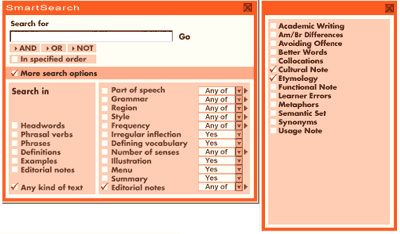|

FROM THE EDITOR
 In
this Issue In
this Issue
 Contributors Contributors
 Letters
to the Editor Letters
to the Editor
 Write
to Us Write
to Us
 Spread
the Word Spread
the Word
 Back
Issues Back
Issues
 Index Index
FEATURE
 A
wish beyond words A
wish beyond words
Richard Cauldwell calls for
a novel way of teaching
listening skills
COLUMNS
 Language
Interference Language
Interference
Borrowings and
false friends between
Russian and English
 Focus
on Language Focus
on Language
Awareness:
Introduction
Numbers
Writing and pronouncing
numbers
UK version ¦
US version
 New
word of the month New
word of the month
New words in sport
 Top
Tips for the CD-ROM Top
Tips for the CD-ROM
MED CD and functional
language
 onestopenglish.com onestopenglish.com
|
 |
Top
Tips for the CD-ROM
by Mairi
MacDonald
The Macmillan English Dictionary contains over
800 usage and language notes (called 'editorial notes' on the CD-ROM),
twelve of which deal with functional language. It's easy to find these
notes on the CD-ROM as well as copy and paste this material so you can
adapt it for your class. Even if your students don't have access to a
copy of the dictionary, you can quickly create worksheets to supplement
any lesson on functional language.
1 Functional language
The functional notes in MED provide common phrases and
a short explanation covering issues such as register and style. The context
in which the phrases are used is presented in example sentences.
These example sentences can be used as a basis for identifying
fixed phrases and studying their structure. They can also provide students
with a template for experimenting with their own sentences.
The functional notes cover the following topics. The headword
where the note can be found is given in brackets.
• giving advice (advice)
• expressing agreement (agree)
• apologizing (apologize)
• saying I don't know (know)
• saying no (no)
• giving your opinion (opinion)
• asking and giving permission (permission)
• persuading someone to do/not to do something (persuade)
• suggesting something (suggest)
• expressing certainty (sure)
• warning someone (warn)
• saying thank you (thank you)
2 Finding functional notes
To find the functional notes, either go directly to one
of the headwords listed above or use SmartSearch to browse the
complete set. To do this, click on SmartSearch and leave the search
box empty. Tick More search options and select Editorial notes.
Click on Functional Note, then press Go. The complete list
of entries containing a functional note will be listed in the bottom left-hand
corner of the screen.

Once you have selected a headword, the note will appear
to the right of the entry. Click on the small box immediately after Functional
Note in the orange title bar. Select Edit and Copy.
You can now paste the contents of this window directly into a word processing
document.

3 Classroom activities
There are many ways you can use this information to create
classroom activities. Here are a few suggestions.
Activity 1 Asking and giving permission
Activity 1A
Procedure: Ask the students what functions the
following sentences have. Students underline the phrases that ask for
permission, then mark the phrases that grant permission with an asterisk
(*).
|
Activity
1A
Decide what function each of these sentences has.
Underline the phrases that ask for permission, and mark the
phrases that grant permission with an asterisk (*).
| Can I take your car to
work tomorrow? |
| You can take the big bag
as well if you like. |
| 'Can I bring my bike inside?'
'Of course you can, there's plenty of space. |
| Would it be all right if
I turned the radio off? |
| 'May I take a bath?' 'Sure, go
right ahead. There's plenty of hot water.' |
| Do you mind if I open a
window? |
| May I use the phone? |
| Guests may only use the
dining room after 6.30 pm. |
| 'Is there any more bread?' 'Help
yourself. It's in the kitchen.' |
| 'Could I stay the night at Ann's?'
'I don't see why not, so long as you're home before lunch
tomorrow.' |
See answers
|
Activity 1B
Procedure: Students decide which of the phrases
from Activity 1A correspond to the explanations.
|
Activity
1B
Decide which of the phrases in Activity 1A correspond
to the explanations below (a-i).
| explanations |
phrases |
|
the most usual and general way of asking permission |
|
|
used informally for making someone feel comfortable about doing
something |
|
|
used informally, especially when talking about food or drink |
|
|
used for showing you do not want to interrupt or annoy someone |
|
|
a more formal and polite way of asking permission |
|
|
a more formal and polite way of giving permission |
|
|
used for showing that you are happy for someone to do something |
|
|
the most usual and general way of giving permission |
|
| used
when you cannot see any reason to prevent someone from doing
something |
|
See
answers
|
As a follow up, elicit a dozen or so sentences starting
with Can I…?, Do you mind if I…? Would it be all right if I
...? etc. In pairs, students take it in turns to ask and grant permission.
It might be an idea to introduce some pronunciation work at this point
to help students sound more natural.
Activity 2 Saying thank you
Activity 2A
Procedure: Students read the phrases and decide
whether they are used in informal or formal situations. Students then
match the explanation with the relevant sentence.
|
Activity
2A
Read these phrases and decide whether they are used
in informal or formal situations. Then match the explanations (1-8)
below with the correct sentences (a-h).
| thanks (a lot) |
| that's very kind of you |
| you've saved my life |
| ta/cheers |
| thanks a bunch |
| you shouldn't have |
| I'd like to thank... |
| many thanks |
| thanks (a lot) |
used when making a formal speech |
| that's very kind of you |
used ironically, when someone has
not helped you at all |
| you've saved my life |
a more informal way of saying thank
you |
| ta/cheers |
the most usual way of saying thank
you |
| thanks a bunch |
an informal way of saying thank
you, used when someone has helped you in a difficult situation |
| you shouldn't have |
a formal way of saying thank you,
used when writing letters |
| I'd like to thank... |
a formal way of saying thank you,
often used when refusing an invitation |
| many thanks |
used when someone gives you a present |
See
answers
|
Activity 2B
Procedure: When students have completed Activity
1B, they fill in the gaps in the sentences.
|
Activity
2B
Complete the sentences using the following phrases.
|
that's very kind of you you
shouldn't have I'd like to thank...
thanks a bunch you've saved my life thanks
a lot
many thanks cheers
|
| __________ for all your help. |
| __________, Mrs Wilson, but I'm afraid we've
already arranged to have lunch in town. |
| Oh, thanks, John, __________! She was just
about to ask me for my homework. |
| __________, mate! I'll buy the drinks next
time. |
| 'You could always join us later.' 'Yeah, __________,
just when all the food is finished.' |
| Oh, __________! These flowers are beautiful. |
| __________my mother, my father, and all those
who've helped me over the years |
| __________ for the lovely present. |
See
answers
|
Activity 3 Ways of persuading someone
to do/not do something
Activity 3A
Procedure: Print out the following table and cut
it into strips. Put students into pairs and get them to match the sentence
halves.
| You know, it might be better if |
you let Maggie drive from now on. You're
looking tired. |
| Why don't you think about |
taking three weeks'' holiday instead
of two? It might do you good. |
| Oh, go on, please |
come to the party! I don't want to go
without you. |
| We'd really like you to |
come with us to France. |
| I think you should |
forget about the whole thing and just
get on with doing your job.
|
| I'd really prefer it if you didn''t |
put your feet on the sofa. |
Activity 3B
Procedure: Go over the answers to Activity 3A,
paying close attention to the correct form of the verb. Then get students
to re-form into small groups and create their own sentences using the
first part of the sentences only.
|





